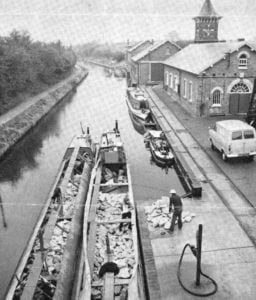We left Edward in the 1930s at the mid-point of his career. By this time he considered himself to be “a Real Canal Man”, a definition meaning to have fallen into the waterway, a feat he accomplished by taking a header over the handlebars of a borrowed bicycle. He also recalls that he saw a postman doing the same thing at Lock 45, Marsworth, when the many letters from his saturated postbag had to be dried out carefully in the Toll Office at that lock.
Edwards informs us that in those days Toll Offices were situated at strategic points to gauge the loaded craft, and this was done with a calibrated rod floating inside a copper tube. Held against the gunwhale of a boat at four different points, it was possible to obtain an average of the number of dry inches above the water for every 5 cwt. of cargo on the craft. A normal load for a pair of narrow boats was something over 27 tons on the motor boat, and 30 tons on the butty. Cargoes included coal from the Midlands and sand from Leighton Buzzard.
Soon after World War II broke out it was considered advisable, in the case of possible invasion, to patrol Marsworth Seven Locks at night, and when Edward’s turn came he would cycle from Tring to the Bulbourne workshop during the late evening to get what sleep he could on a mattress in the storekeeper’s house before starting his patrols at 2 a.m. Armed with a rifle to repel Nazi invaders, Edward trudged nightly the stretch of towpath between Bulbourne and The White Lion at Startops End. On many nights he was horrified to be able to see from Bulbourne Canal Bridge the glow in the sky from the bombing over London. He records that one large bomb fell on the offside bank in Tring Summit just north of Bridge 135. It made a crater of about 70 ft. in diameter and dislodged several trees into the water. With the assistance of the Royal Engineers and a steam dredger, the waterway was soon cleared so essential supplies could be on the move again.
As the war progressed manpower grew short, and many young society ladies helped by forming crews to run commerical craft from London to the Midlands. Edward was full of respect for these previously-pampered girls, as he knew exactly what it meant to handle wet ropes in icy weather. He remembered seeing a boat whose cargo had slipped, sinking as it drew alongside Bulbourne Works, and he admired the girl who dived down several times into the flooded cabin to rescue her belongings.

After the war Edward received promotion and was in charge of a newly-established training centre at the Bulbourne office. Personnel came from all over the country, and the courses covered every aspect of canal management from fluctuations of water supply to damage to canal property. Further promotion followed and Edward ended his career as Assistant District Inspector, being given charge of the Watford District (a 60-mile length from Lock 21 Cosgrove to Lock 101 Brentford – plus six branch canals including the Wendover and Aylesbury Arms).
To conclude these snippets from Edward’s reminiscences I quote his words “What happens to the water after it has served its purpose for canal traffic. Where does it go to?” referring to the vital supply flowing from the Chiltern Hills. Via the Aylesbury Arm and south of Tring Summit the water finds its way by overflow weirs and streams down to the River Thames, and the same applies just north of Marsworth Seven Locks. From Lock 34 Seabrook to the 11 mile-long Fenny Pound until it reaches the next high level, surplus water finds its way by the rivers Ouzel, Great Ouse, Nene etc. to discharge into the sea at the Wash on the east coast.
Edward Bell retired in 1966 after, what he considered to be, a rewarding and fascinating working life. During the early part of this period, he also assisted his twin brother, George, in a small photography business in Tring. In a future issue of Village News, space permitting, I will show one or two photographic images of the villages taken by the Bell brothers and sold as postcards.
Wendy Austin lives in Tring and has published a number of books on local history including ‘Tring Personalities’ (3 volumes), ‘Tring Gardens: Then and Now’, and ‘Tring Silk Mill’.
Article appeared in the Village News October 2009 page 8




